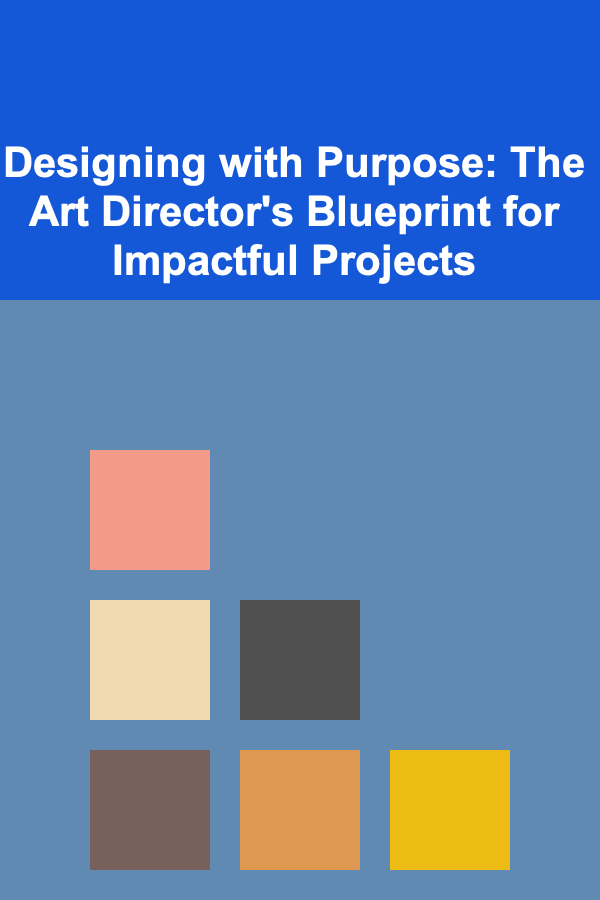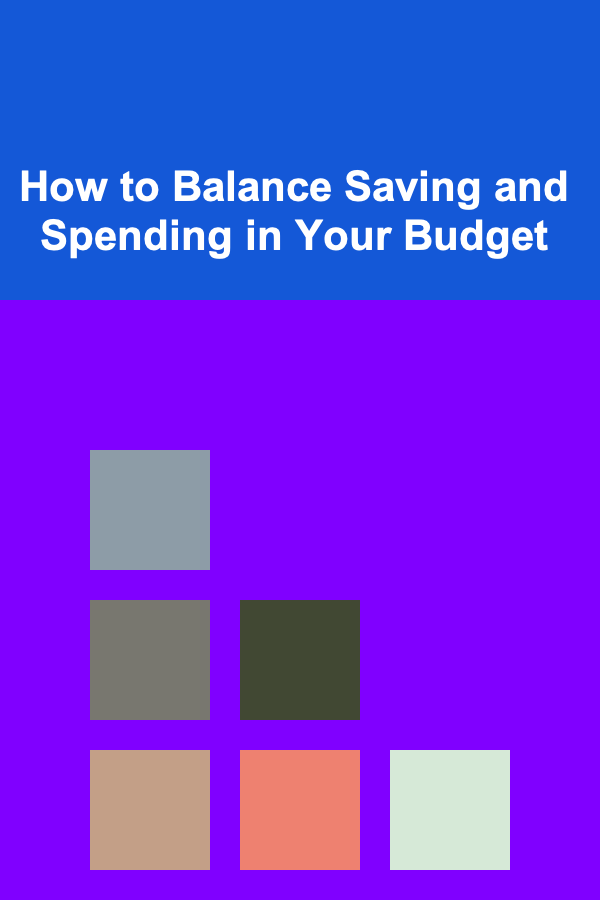
Designing with Purpose: The Art Director's Blueprint for Impactful Projects
ebook include PDF & Audio bundle (Micro Guide)
$12.99$5.99
Limited Time Offer! Order within the next:

In the world of visual design, the role of the Art Director stands as one of the most dynamic and influential positions. Whether crafting the visual identity of a brand, directing an advertising campaign, or overseeing the design of a product, the Art Director is responsible for translating concepts into compelling visual experiences. But beyond just making things "look good," great art direction is about creating with purpose. It's about telling a story, conveying a message, and creating something that resonates with the audience.
In this actionable guide, we will explore the core principles, strategies, and best practices for designing with purpose as an Art Director. From establishing a clear vision to refining the smallest details, we will cover the blueprint for impactful design projects that leave lasting impressions.
Understand the Project's Core Purpose
Before any design elements are chosen, the most important first step is to understand the essence of the project. The purpose, goals, and intended outcomes should be crystal clear. Art direction without purpose is like setting out on a journey without a map---there's no clear direction or intent.
Actionable Steps:
- Engage in Deep Discussions with Stakeholders: Understand the project's objectives by speaking with clients, marketing teams, and content creators. Ask open-ended questions that get to the heart of the project's vision.
- Define the Target Audience: Who is the design for? Understanding the demographics, preferences, and expectations of the target audience will help you make design decisions that resonate deeply with them.
- Clarify the Message: What message needs to be communicated? Is it about luxury, simplicity, innovation, or reliability? The message should guide all visual decisions, from color choices to typography.
By ensuring that you are aligned with the project's core purpose, you can ensure that every design decision, from the broadest strokes to the smallest details, contributes to a unified, impactful result.
Develop a Strong Visual Identity
Once the purpose of the project is understood, the next step is to develop a strong, cohesive visual identity. This identity should reflect the essence of the project and the brand, establishing a tone and mood that speaks to the target audience.
Actionable Steps:
- Color Palette: Choose colors that reflect the emotional tone of the project. For example, warm tones can evoke feelings of comfort and friendliness, while cool tones can create a sense of professionalism and calmness. Be mindful of color psychology.
- Typography: Typography is not just about choosing fonts; it's about selecting the right voice for the brand. Serif fonts often convey tradition and professionalism, while sans-serif fonts can give a more modern and clean look. Consider readability and accessibility as well.
- Imagery and Photography Style: Whether you use illustrations, stock photos, or original photography, ensure that the visual style is consistent throughout the project. For instance, a luxury brand might use high-quality, refined images, while a playful brand might use more whimsical illustrations.
- Consistency is Key: A cohesive visual identity ensures that the design feels like a unified whole. Make sure your design elements work together, from digital interfaces to print materials. Everything should feel like it's part of the same story.
Example:
Imagine designing a website for a tech startup. A minimalist, clean design with modern sans-serif fonts and a cool color palette could be appropriate for a high-tech feel. On the other hand, a website for a children's toy company might use vibrant colors and playful illustrations to appeal to a younger audience.
Create with Storytelling in Mind
Effective design goes beyond aesthetics---it's about crafting an experience that tells a story. Every element in your design should serve to communicate a narrative, whether it's through imagery, layout, or the overall structure of the project. The concept of storytelling in design helps humanize the experience and connects with people on an emotional level.
Actionable Steps:
-
Identify the Story Arc: What is the overarching narrative of the project? Whether it's a brand story, a product journey, or a marketing campaign, the design should be structured in a way that follows a clear story arc.
- Example: A campaign for a charity organization could follow a journey from awareness (shocking imagery) to action (how to get involved) and finally impact (testimonials and success stories).
-
Use Visual Hierarchy: The layout should guide the viewer through the story, starting with the most important elements and moving to the lesser ones. The use of scale, contrast, and alignment can create a clear path for the viewer to follow.
-
Incorporate Emotional Design: Create designs that evoke emotions. Think about how users or viewers will feel when they interact with your design. Does it inspire hope, excitement, trust, or nostalgia? Emotional connection is a key factor in storytelling.
Example:
In an advertisement for a sustainable product, you might start with images of environmental destruction (to create a sense of urgency), transition to images of the product being used (showing its solution), and end with a powerful call to action (reinforcing the message of making a difference).
Focus on User-Centric Design
The effectiveness of any design lies in how it serves its users. A great Art Director always keeps the user experience at the forefront, ensuring that the design is not only beautiful but functional and intuitive. Whether it's a website, product, or advertising campaign, the user's journey should always be the priority.
Actionable Steps:
- User Research: Conduct research to understand user behavior, needs, and pain points. Use surveys, focus groups, or analytics to gather valuable insights.
- Test and Iterate: Don't assume your design is perfect at first. Prototype your ideas, conduct usability testing, and gather feedback. Refine and improve your design based on real-world interactions.
- Accessibility: Ensure that your designs are accessible to all users, including those with disabilities. This includes things like color contrast, font legibility, and alt text for images.
Example:
When designing a website for an e-commerce store, your design decisions should prioritize a seamless shopping experience. This includes an easy-to-navigate layout, intuitive buttons, and fast load times. Every design choice should support the user's goal of making a purchase.
Embrace Collaboration
Art direction is rarely a solo endeavor. As an Art Director, it's crucial to foster collaboration with other team members, including graphic designers, copywriters, developers, and marketers. The best projects come together when everyone is working toward the same goal, with a shared understanding of the design vision.
Actionable Steps:
- Build Strong Relationships with Other Teams: Make sure to establish open lines of communication with all departments involved in the project. Regular meetings and feedback loops are essential to align everyone with the overall vision.
- Collaborate on Ideation: Brainstorm with your team, keeping in mind that everyone's input can help refine the design process. Diverse perspectives can spark innovative ideas.
- Delegate Tasks Effectively: As the leader of the project, it's important to recognize the strengths of your team members and delegate tasks accordingly. This ensures that each aspect of the design gets the attention it needs.
Example:
While working on a brand campaign, collaborate with a copywriter to ensure that the visuals and the messaging align perfectly. A good collaboration between the visuals and the copy can elevate the project's impact.
Pay Attention to the Details
In design, it's often the smallest details that make the biggest difference. Whether it's the spacing between text, the alignment of elements, or the subtle texture in a background, these details can elevate the design from "good" to "great."
Actionable Steps:
- Refine Layouts: Pay attention to grid systems, margins, and paddings to ensure that everything is well-aligned and proportionate.
- Optimize Visuals: Ensure that images and graphics are high quality, optimized for web or print, and contribute to the overall aesthetic. No pixel should be out of place.
- Consistency Across Platforms: Ensure that your design remains consistent across different platforms and mediums, from digital screens to print brochures.
Example:
In a print ad, the kerning of typography and the positioning of images can be crucial in making sure the message is easily read and visually pleasing. These fine-tuned adjustments can make all the difference.
Conclusion
Designing with purpose is the hallmark of an effective Art Director. Every project, whether big or small, should be rooted in a deep understanding of its goals, audience, and message. By developing a strong visual identity, telling a compelling story, focusing on user-centric design, collaborating with others, and paying attention to detail, Art Directors can create designs that are not only beautiful but also impactful.
The art of art direction lies in more than just aesthetics. It's about making design decisions that align with purpose, elevate the user experience, and leave a lasting impression. Through careful planning, thoughtful execution, and continual refinement, Art Directors can ensure that their projects make a real, lasting impact.
Reading More From Our Other Websites
- [Home Budget 101] How to Budget for Major Life Events While Keeping Your Home Expenses Low
- [Home Security 101] How to Use Video Doorbells for Enhanced Home Security
- [Personal Investment 101] How to Assess the Risks and Rewards of Corporate Bond Investing for Beginners
- [Personal Care Tips 101] How to Choose a Budget-Friendly Conditioner That Works Wonders
- [Home Cleaning 101] How to Revive Your Toaster Oven: A Comprehensive Cleaning Guide
- [Organization Tip 101] How to Use Antique Preservation Techniques for Longevity
- [Paragliding Tip 101] Gear Guide: Best Lenses, Filters, and Mounts for Paragliding Photography
- [Personal Care Tips 101] How to Use Body Spray for a Fresh and Clean Feeling All Day
- [Organization Tip 101] How to Create a Drawer for Holiday Baking Supplies
- [Organization Tip 101] How to Create a Family Message Center in Your Laundry Room

How to Balance Saving and Spending in Your Budget
Read More
How to Build a Checklist for Staying Updated with Social Media Trends
Read More
How to Build Customer Trust and Loyalty When Selling Online
Read More
How to Design a Checklist for Handling Email Campaign Responses
Read More
How to Understand the Basics of Annuities
Read More
How to Plan Baby's First Year Health & Wellness
Read MoreOther Products

How to Balance Saving and Spending in Your Budget
Read More
How to Build a Checklist for Staying Updated with Social Media Trends
Read More
How to Build Customer Trust and Loyalty When Selling Online
Read More
How to Design a Checklist for Handling Email Campaign Responses
Read More
How to Understand the Basics of Annuities
Read More